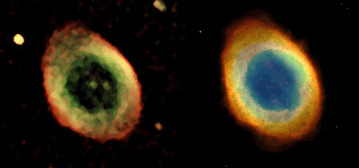Looking Down a Tunnel of Gas at
the Last Gasp of a Doomed Star

Except for the rings of Saturn, the Ring Nebula, M57, is probably the most viewed example of a celestial band in the night sky. It's located about 2000 light years away, but because of its high surface brightness, its easy to spot even with small telescopes. The nebula itself is one light year across which is about 1000 times the size of our solar system. Observing the ring from Earth, we are actually looking into the end of a barrel shaped cloud of gas which has been spewn off by a dying star. As seen in the above images, blue gas near the hot central star gives way to cooler green and yellow gas at greater distances with the coolest red gas located along the outer boundary. The central stars ultimate fate is to probably end up as a white dwarf about the size of planet Earth.
I took the image on the left with my 8" SCT scope and a Toucam webcam on 6/21/04 at 12:18 am. The image on the right was taken with NASA's Hubble Telescope.
Note: The two stars seen in the central part of the left image are not actually located within it. The central star that created the nebula is very faint and difficult to observe even with large amateur telescopes. The faint speck at the very center of the Hubble image on the right is the actual dying star.
Quote: "I first saw the Ring through a small telescope in my back yard, when I was a high-school student in the 50's. My astronomy books taught me that it was a round sphere of expanding gas." In fact, the round shapes of planetary nebulae when seen in small telescopes gave rise to the name two centuries ago: their circular disks resemble those of planets, and thus they were called nebulae with a "planetary" shape."
from The Ring Nebula Project
*See the Archives on the left for more astrophotos*
Correction: It appears that the star in the center of my image of M57 is actually the dying star spoken of above. The Toucam webcam with an 8" scope, especially with a 60 sec exposure as this was, is perfectly capable of imaging a 15.3 mag star such as this one. So, in fact, this is the central star! Look at the bottom page of this link and you'll see how the stars match up: Catching The Light (thank you, Jerry Lodriguss)
*See the Archives on the left for more astrophotos*




